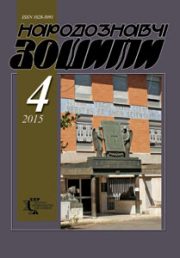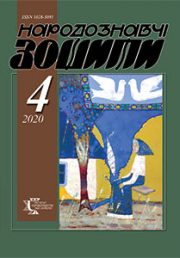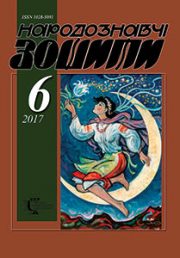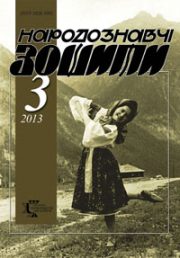The Ethnology Notebooks. 2022. № 4 (166), 987—994
UDK 811.161.2’373.232.1:355.425.4(477.8)”19″УПА
DOI https://doi.org/10.15407/nz2022.04.987
METHODS AND MEANS OF FORMING INSURGENT PSEUDONYMS
SOKIL-KLEPAR Nataliya
- ORCID: https://orcid.org/0000-0002-4156-5978
- Ph. D., Associate Professor,
- Lviv Ivan Franko National University,
- The Ukrainian Language Department
- named after professor Ivan Kovalyk,
- 1, Universytetska Str., 79001, Lviv, Ukraine,
- Contacts: e-mail: nsokil@ukr.net
Abstract. Main means and methods of forming UIA pseudonyms have been considered in the article. Pseudonyms are units of secondary nomination that appeared as a result of important social and political factors. Pseudonymisation usually uses ready lexical units (words, phrases) for naming persons. Each pseudonym is formed according to a certain word-forming model. Results: Most hidden names arose as a result of semantic method of creation (appellatives onymization and transonymization). Associativeness and imagery played an important role here. In insurgents’ pseudonymicon dominant thematic groups «Man» and «Nature» have been singled out. Within their limits, pseudonyms have been interpreted according to lexical-semantic groups. Names for body parts (Tooth (Зуб), Hair (Волос)); ancestral (Grandma (Баба), Father (Батько)), social (Cantor (Дяк)), geographical (Highlander (Горак)) affiliation; household vocabulary (Tank (Бак), Key (Ключ)); plants (Acacia (Акація), Viburnum (Калина)); animals (Bear (Ведмідь), Serpent (Вуж)); seasons (Spring (Весна), Winter (Зима)), etc. were most typical for formation of insurgent pseudonyms. Pseudonyms such as Vlodko, Dara, Oleksa, Crimea, Donets, Cheremosh, etc. were formed by means of transonymization. Some pseudos arose as a result of morphological and syntactic method of word formation from derivative and non-derivative qualitative adjectives (Crimson (Багряний), Deaf (Глухий), Heady (Головатий)).
Pseudonyms were also created by compounding but a small number (Long-Nose (Довгоніс), Throat-Cutter (Горлоріз)). Morphological way in pseudonymisation is also rarely implemented and is usually materialized through anthroponym-fomative affixes -iv, -enko, -ak(-yak), -uk(-chuk) (Danyliv, Andriienko, Baidak, Zakharchuk). By structure, pseudonyms are implemented as single- (Hutsulyk, Lelyk, Fesko) and multi-component formations (Maksym Cutter (Максим Рубан), Cherry-6 (Вишня-6)) with the first group significantly prevailing.
Conclusion: The analyzed pseudonyms have been formed in the traditional way of unofficial naming and are an important component not only in Ukrainian anthroponymy, but also in the nationwide language picture of the world.
Keywords: pseudonym, mean, method, structure, nomi nation.
Received 13.08.2022
REFERENCES
- Panko, T., Kochan, I., & Matsyuk, H. (1994). Ukrainian Terminology. Lviv [in Ukrainian].
- Taranenko, O.O., & Rusanivskyi, V.M. (Ed.). (2007). Nomination. Ukrainian language: Encyclopedia (Pp. 417—419) [in Ukrainian].
- Luchyk, V. (2011). About the peculiarities of nomination in the toponymy of Ukraine. Bulletin of the Carpathian National University. Philology. (Issue XXIX—XXXI, pp. 21—24) [in Ukrainian].
- Shutak, L. (2014). Secondary nomination as a problem of modern theoretical linguistics. Scientific notes of Vinnytsia State Pedagogical University named after Mykhailo Kotsiubynskyi. Series: Philology (linguistics): collection of scientific works (Issue 20, pp. 68—74). Vinnytsia. Retrieved from: https://core.ac.uk/download/pdf/144956958.pdf [in Ukrainian].
- Vakaryuk, L., & Pantsyo, S. (2007). Ukrainian vocabulary in terms. Dictionary-reference. Ternopil [in Ukrainian].
- Zahnitko, A. (2020). Modern linguistic dictionary. Vinnytsia [in Ukrainian].
- Potapenko, O., Kotsura, V.P., & Potapenko, O.I. (Eds.). (2015). Water. Encyclopedic dictionary of cultural symbols of Ukraine (Pp. 143—145). Korsun-Shevchenkivskyi. Retrieved from: https://cutt.ly/DT2nCTw [in Ukrainian].
- Nelyuba, A. (2006). Basic and word formation in the context of word-forming nomination. Bulletin of Zaporizhzhya National University. Philological sciences, 2, 169—184 [in Ukrainian].
- Nalyvayko, M. (2017). Typology of the system of word formation of nicknames of residents of Lviv Oblast. Bulletin of Lviv University. Philological series. Lviv (Issue 64, ch. I, pp. 74—81) [in Ukrainian].
- Nimchuk, V. (1966). Ukrainian onomastic terminology (Project). Notice of the Ukrainian Onomastic Commission (Issue I, pp. 24—43). Kyiv [in Ukrainian].
- Chuchka, P. (1969). Anthroponymy of Transcarpathia: diss. … to obtain sciences. degree of doctor of philology. Sciences: 10.661 «Languages of the Peoples of the USSR (Ukrainian)». Uzhhorod [in Ukrainian].







